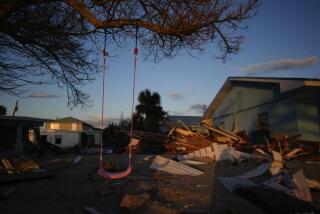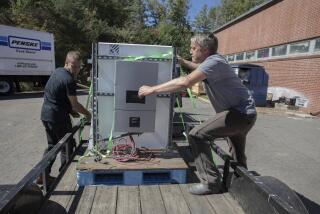Hurricane Ebbs After Devastating Parts of Louisiana : Weather: Andrew claims 20th life in 5-day rampage. Hurricane destroys homes, sinks a tugboat and causes power outages before it diminishes to a tropical storm.
MORGAN CITY, La. — Hurricane Andrew wheezed out Wednesday over the battered plantations of Louisiana and flung a final tornado into neighboring Mississippi after claiming a 20th life on its five-day trip of terror from the Bahamas.
At noon CDT, the hurricane degenerated into a tropical storm, with sustaining winds of less than 74 m.p.h. It nudged northward toward Natchez, Miss., blowing at 55 m.p.h. Including the damage it caused in Florida and Louisiana, Andrew was America’s costliest disaster ever.
It outstripped Hurricane Hugo’s damage three years ago in the Carolinas by at least $5 billion. In Louisiana, Andrew destroyed homes, flipped trailer houses and uprooted mighty oaks. It sunk a tugboat on the Mississippi River, scattered barges helter-skelter in the Gulf of Mexico and tumbled thousands into power-outage darkness.
It spared New Orleans. Instead, it spread its devastation across a 50-mile-wide swath with Morgan City at its center, where the eye of the hurricane hurled ashore.
President Bush declared the state a federal disaster area and flew into Lafayette while Andrew was still a gusty downpour.
“The destruction from this storm goes beyond anything we have known in recent years,” the President said. “Literally millions of American citizens today find themselves in the midst of personal devastation.”
His visit and the aid a disaster declaration brings illustrate the power of incumbency during a presidential campaign. Bush took nine days before visiting the Carolinas in 1989 when they were devastated by Hugo, which held the previous record for destruction. He also waited until one day after Hugo to declare a disaster--and was criticized for the delay.
This time, Bush visited Florida the day Andrew struck Miami earlier this week.
Democratic presidential candidate Bill Clinton expressed sympathy for the hurricane victims in both states and asked Americans to help them. He got a damage assessment from Louisiana Gov. Edwin W. Edwards and said “our hearts and prayers are with those folks.”
Rep. W. J. (Billy) Tauzin (D-La.), who accompanied Bush to Lafayette, predicted that more than $1 billion would be needed to repair the damage Andrew did in Louisiana. That contrasted to estimates that Andrew inflicted $15 billion to $20 billion worth of damage in Florida. Added together, the total easily topped Hugo’s national record of $10 billion.
The hurricane’s death toll was moderate. Four fatalities were reported in the Bahamas; 15 in Florida and one in Louisiana--a 63-year-old man whose body was discovered in the rubble of two tornadoes that Andrew hurled into St. John the Baptist Parish late Tuesday. Thirty persons were injured in the parish.
In its last fury, Andrew lashed out at Mississippi with a tornado that caused damage and injured at least one person. But most of its destruction came in the bayous of Louisiana. About 75 homes were demolished in St. John Parish and an additional 30 were severely damaged. Wreckage was prominent along U.S. 90 from Lafayette to New Orleans.
At the center of an arc formed by the highway lay Morgan City, which took the eye of the storm. Its downtown area butts against a seawall along the Gulf of Mexico. Almost every window in the town that was not boarded up was broken. Trees were uprooted and metal roofs were twisted off buildings. Telephone and power lines were down.
For 30 miles north and east of the city, hundreds of lost and bewildered sea birds were scattered along the roadways and through the cane fields. Some were hit by cars. Residents speculated that Andrew had carried the birds all the way from Florida and the Bahamas.
At a 19th Century City Hall, Mayor Cedric S. LeFleur requested National Guard troops to help prevent looting. He sat in his second-floor office taking reports of wreckage. Buckets caught rainwater dripping through his roof.
“I’d say $5 million worth of city property alone has been damaged,” he said. “There’s damage to the municipal power plant. There’s heavy damage to City Hall, to the courts, to the Police Department, to the auditorium.
“Electricity will be several days before we get it up and running. Now we’re trying to get the sewage plant going. That’s a very dangerous proposition, if we can’t get the sewage plant open and running before people start to come home.” LeFleur paused. “It (the hurricane) was bad. This was my worst one.”
He said two-thirds of Morgan City’s 15,000 residents fled before Hurricane Andrew hit. Because of that, he said, there were no casualties.
At the outskirts of town, the Grizzaffi family grieved nonetheless.
Their business, Leo’s Tire & Service Center, suffered heavy damage. Leo Grizzaffi Jr., son of the proprietor, had stayed behind despite the evacuation. He took shelter in his parents’ house--on a mattress in the hallway. They had fled town.
Next to him, Grizzaffi kept a radio, a candle and cold drinks.
The hurricane hit hardest between 1:30 a.m. and 4:30 a.m. “It was like the sound of a mad animal outside,” he said, “the deep, groaning sound of a wounded animal. Every now and then, when the howling got loud, I looked outside and saw trees and garbage cans flying.”
After the storm passed, he drove to the family business.
“I came expecting to see windows broken,” he said. “I didn’t expect this.” He pointed at portions of a demolished wall, a ripped-out ceiling, broken glass and two shelves of merchandise littering the floor: everything from green, orange, pink and yellow gumballs to batteries to car bumpers.
At that moment, his parents drove up. Grizzaffi’s mother, Tena, was sobbing.
“I hate to see my mama cry,” Grizzaffi said.
Tears on her cheeks, she embraced him. “Thank God we’re all alive,” she said. “But look at how hard we’ve worked (for nothing).”
In Franklin, about 20 miles to the northwest along U.S. 90, Evelyn Thibodaux knew she had made a major mistake by not evacuating. She had heard the wind coming up--and hid in her bathroom.
She sat there as her small brick home began to shake. The winds topped out at more then 100 m.p.h. and the roar was deafening. The shaking was so fierce that a door shook loose from its lock. “I stayed,” she said, “and I was scared to death.
“The next time they say evacuate, I will,” she said, ruefully. “I was afraid to leave because I thought someone would rob us. We’ve stayed before and it never got this bad.”
Outside, a radio tower was twisted over double. Windows were blown out everywhere, and fallen trees made many of the roads impassable. Signs were blown away or twisted and sheet metal sliced into the street like huge razor blades. When the wind stopped howling, Franklin was a ghost town.
At the courthouse, sheriff’s deputies talked in awe of the storm. They said that it blew a wind indicator off the outside wall after the device registered gusts of 180 m.p.h.
“There used to be an air conditioner there,” said deputy Jeffrey Colonna, pointing to a spot in the county communications center covered by plywood. “It (the air conditioner) came whistling through here.”
Colonna muttered: “They couldn’t pay me enough to stay here the next time.”
Farther along Highway 90 to the northwest, large strips of metal were wrapped like ribbons around trees and poles. Andrew had yanked them from the sides of trailer houses and torn them from the roofs of barns.
At Jeanerette, in plantation country, many of the 2,000 residents fled their trailers and wooden frame houses to take refuge at a high school. But they found little safety.
As Hurricane Andrew hovered overhead, the roof of the girl’s gymnasium began to give way. The room was already pitch black, because power was out and there was no auxiliary electricity. About 350 people huddled on mattresses and blankets.
“People started running around,” said Winifred Narcisse, who sat on the gymnasium floor with her son, Justin. “It was like thunder. It started cracking, and glass was flying all over. A pregnant lady got stepped on as people rushed to get out of the way.”
Roy Jackson sat helplessly nearby.
“It was crazy,” he said. “All of a sudden the wind ripped the old top right off and water came flowing in everywhere.”
Within minutes the floor of the gymnasium was soaked.
“We managed to get everybody out of there safely,” said police chief Ted Kahn. “Nobody was seriously injured.”
He called it a miracle.
Most of the massive homes on the old plantations around Jeanerette withstood the hurricane well. They were built in the middle 1800s.
One of them, Bay Side Plantation, sat untouched in a yard littered with fallen trees. Wind whistled eerily through their broken limbs and the Spanish moss and ivy that covered them--but the plantation house stood unharmed.
At New Iberia, about 10 miles from Jeanerette, Hurricane Andrew hovered above the town for more than an hour.
Peggy Creighton assembled all of her family in Mabel’s Lounge to wait it out. The bar was preferable to the family’s trailer house.
“We knew we wouldn’t be safe there,” she said.
She and her family and friends slept on the floor of the tavern and on its pool tables. “The scariest place was in the bathroom,” she said. “It was horrible. You could hear the wind and the rain whistling around. It was like being inside of a metal drum that someone was banging on.
“I looked outside the window and saw tin flying everywhere.”
Across town at Dauterive Hospital, a modern, three-story, brown brick structure, all of the first-floor windows were boarded up. Most of the second- and third-floor windows were taped--but it turned out this was not enough.
When the hurricane hit at full force, many were blown out.
Hospital staff members moved patients into the hallways. Some were shaken up but Don Bordelon, the human resources director, said there were no injuries. “We were terrifically fortunate,” Bordelon said.
All along Highway 90, utility poles were snapped in half. Mammoth, century-old oaks were splintered. Hundreds of other trees were split or uprooted. Sugar cane fields lay flattened and bare.
In the other direction along the highway east of Morgan City, the hurricane severely damaged several trailer homes and left Forrest LaCoste determined never to ride out another storm like Andrew again.
“Next time,” LaCoste said, “I’m getting a U-Haul truck and I’m gone. I don’t want any more of it.
“I will go till I run out of gas.”
But not forever, he said.
LaCoste, a Cajun with a salt-and-pepper mustache, said he would return. “I ain’t going to leave my country,” he said. “I was born here; I will die here. I just don’t want to die in a hurricane.”
Farther to the northeast, at Gibson, the hurricane knocked down trees on the average of 11 every hundred yards. Cars wove their way around them.
Some of them drove on lawns to do it.
Still farther, at Houma, a sign at the edge of town proclaims: “Cleanest City Contest Winner.”
But the hurricane left behind a huge cleanup problem.
Debris littered roadways, along with tree limbs and common garbage. Worse, the town was flooded.
“Our problem is that with all the electricity out none of the drainage pumps are working,” said Capt. John Dixon of the Houma Police Department, puffing on a cigar. “It’s just grin and bear it.”
Water was knee deep outside the police station.
Between Houma and New Orleans, the damage diminished. Driving was dangerous, however, across the Huey P. Long Bridge over the Mississippi and into New Orleans suburbs. Although the speed limit was 45 m.p.h., motorists crawled at 5 m.p.h. or less.
Hours after the hurricane played out, rain fell so heavily on the bridge that drivers could not see the hoods of their cars.
In New Orleans, power company officials reported 200,000 people without electricity.
Trees were down, and streets were vacant.
But there was little major damage.
Times staff writers J. Michael Kennedy in Franklin, La., and Richard E. Meyer in Los Angeles contributed to this story.
RECOVERY AID: Bush pledges $10 million for cleanup jobs in Florida. A21
America’s Most Destructive Storm
Deaths: 1 in Louisiana, 15 in Florida, 4 in the Bahamas
Damage: Up to $20 billion in Florida; estimate of $1 billion for Louisiana
Left homeless: 63,000 homes destroyed, 180,000 homeless in Florida
Power outages: Nearly 2 million without electricity in the two states
More to Read
Sign up for Essential California
The most important California stories and recommendations in your inbox every morning.
You may occasionally receive promotional content from the Los Angeles Times.










